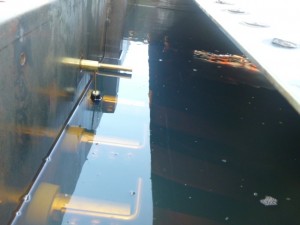
Inside of Oil Filled Transformer

Inside of Oil Filled Transformer
There seems to be some mystery around pad mount transformers. And not just the green boxes in residential back yards. Even the larger pad mount power transformers used by manufacturers seem to be a mystery to many folks. During a routine quarterly RCM (Reliability Centered Maintenance) Inspection of a manufacturing plant’s power transformers, MIDWEST detected a small amount of oil weepage on the concrete pad under one transformer. It was a 2000 Kva, 24,940Y/14,400 volt to 480Y/277 volt unit built in 1993 with 740 gallons of oil in it. When we explained to the owners that the main power transformer for their product assembly and finishing area was filled with oil and the oil was weeping out of the transformer, they almost thought we were joking. They had no idea the transformer was oil filled. A little walk, inspection, and explanation and we could tell it was now as clear as mud to them. They needed some pictures of the inside of the transformer. Oil weepage from a power transformer is nothing new, but this 2000 Kva power transformer went from no signs of weepage or leakage to a stained pad within 90 days. The cause was later determined to be a cracked bushing, which is very rare. In our report MIDWEST included pictures of the inside of a similar transformer. The images showed the oil inside the tank. Also showed the bushings extending inside the transformer under the oil and showed the liquid level gauge. Oddly enough, it was the oil level gauge that gave them the epiphany they needed to understand comfortably. These images are always very helpful as a “Seeing is believing” tool.
MIDWEST sells new oil filled large Kva and very large Mva power transformers. But because MIDWEST buys electrical equipment to remanufacture and resell, we get calls from demolition companies and electrical contractors asking what they should do with old oil filled power transformers. They are concerned with the PCB rules regulating oil filled transformers. As an example, MIDWEST had a project to remove the electrical switchgear from a large industrial facility. The demolition company wanted to sell the oil filled transformers in the main outdoor substation right by the building to be torn down. But no legitimate company would take them without the PCB classification certification. The demo company figured the oil recyclers would be happy to buy the old oil and the metal scrap companies would be happy to buy the empty transformers. But they all wanted certification of the PCB classification. The demo contractor asked MIDWEST for some advice, because they were ready to start tearing down the building the next day. Our strong advice was simple. Do not touch the transformers. Do not risk damage to the transformers. Don’t take any chances. And do not trust a “Non PCB” label unless there is documentation of the Non PCB classification and have certification the transformers have not been serviced since that analysis was performed. MIDWEST strongly recommends sampling the transformers by qualified personnel and testing the transformers for PCB and PCB Classification regardless of existing labeling. For decades, oil filled transformers have been labeled Non PCB by manufacturers. Most old transformers have been tested and labeled. The owner should have the documentation or the label should identify the lab that did the analysis. A call to the lab with the location, owner, and serial number may be all that is needed for the lab to ID their analysis. A quick email from the lab should confirm the Non PCB classification and the owner must certify no service has been performed on the oil since the respective analysis. It is very important the demolition company keep a copy of that analysis and certification as Non PCB. If the classification can not be documented, we strongly recommend “do not touch the transformers” until they can be sampled and the Non PCB classification confirmed. Do not move them. Do nothing that has any chance of damaging the transformers and causing a spill. It is not worth it. The seriousness of this is deceiving because the rules for using the transformers are very simple, but the risk is incredible. If anything happens and you spill PCB contaminated oil, the consequences could be disastrous. You may have just gone out of business. Also, oil leakage or weepage from old oil filled power transformers must be properly cleaned up per EPA requirements.
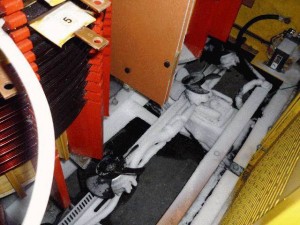
Snowed In 1500 KVA Dry Type Transformer
What happens when you ship a 1500 kva dry type power transformer in the winter, up North, without properly tarping it? It gets 86’d. Send it back. We don’t want it. Besides the snow and ice, there will be dirt, small debris, and very sad faces. Pictures do not do justice to the amount of snow and dirt on the windings. It can be a chore securing a dry type power transformer for shipment, what we call “Bagging it,” but it has to be done. Hidden openings in the tarping on the bottom are usually the culprit. Driving in the rain can be even worse if there is any opening in the tarp. When this happens there’s a lot of discussion about cleaning the transformer and drying it; Procedures; Warranties; Who’s going to pay for the shipping; and, of course, who is going to pay for a new transformer because the customer sure does not want to accept a brand new but wet and dirty 1500 kva, 13,200 volt to 480/277 volt transformer. It’s deficient. That’s all they know. Any suggestion the warranty protects the customer’s interest is met with open anger. A warranty is only for 2 ½ to 5% of the expected life of the transformer. And the cost of taking out an old unit and installing a new transformer can be horribly expensive. A large dry type power transformer is sometimes buried deep within a building’s structure. Sometimes the building has expanded around the transformer substation. We have seen many projects where the cost of the replacement transformer was less than the cost of the installation. Think of the cost of not properly securing the transformer from rain, snow and road dirt as being $1,500.00 per minute of the time it would have taken to do it right. Fortunately this does not happen very often.
What is the hardest part of a project to furnish and install a 100 MVA GST Power Transformer? Like most difficult questions, the immediate answer is, “It depends.” As someone who has actually worked in the field on switchgear and transformers, I think the hardest part is getting the transformer to the final installation site, especially if the site is in South America. Getting it from the manufacturing floor to the installation site and on the pad without any bumps, so to speak. This is a huge worry because things can happen that are out of your control. At least on the manufacturing floor and at the installation site, you usually have total control. Performing the engineering, specification, physical design, and identifying auxiliary devices can be tedious and requires diligence. Commissioning on site is a lot of work and there are plenty of opportunities for things to go wrong. But you are in control, except for the weather. The really big worry starts when that 100 MVA transformer leaves the manufacturing plant door for South America; gets transported to the exporting site; ships over a lot of water to the destination dock; gets unloaded; then gets transported overland again to the construction site; and finally gets rigged and craned on to the concrete pad. And all this action is monitored with an attached, very sophisticated, “Impact Recorder” that monitors and records bad things that may happen to the transformer from the time is leaves the manufacturer to the time is rests on the pad, one ocean and 1000s of miles away. At the end of the trail, so to speak, the data on the monitor is downloaded to a computer and analyzed for the possibility of damage to the huge and very costly mega VA GST Power Transformer. Nerve wracking. So, I vote transportation to be the hardest part of a project involving large MVA Oil Filled Power Transformers.
Here is an example of the success of an Unlimited RCM (Reliability Centered Maintenance) program for large kva and Mva oil filled power transformers. Our Engineering Technicians and Engineers know what the most common problems are for oil filled electrical power transformers, whether 1000 Kva, 5000 kva or 25 Mva. We do the more glamorous transformer tests, but most of these require an outage, which has become unheard of for many large manufacturing facilities and some small municipal utilities. Fluid samples for routines and GCs on dielectric fluid still can be taken safely in some cases. But a hard focused inspection by an experienced, trained, and knowledgeable expert will find many of the probable, but unapparent, deficiencies in oil filled power transformers. Someone following a simple TC Checklist is nearly useless. By TC Checklist, MIDWEST means a “Training Chimpanzee” Checklist. The person performing the service has to think. They have to focus or they will miss subtle things that individually may mean nothing, but collectively may reveal a serious problem or danger. We find things others have looked right at and missed. Some of the things we look for are hard to explain. Others, that seem obvious to the pros, may be invisible to the inexperienced. MIDWEST’s Unlimited RCM Services have saved customers more money than all the transformer testing put together. Here is a simple example of a fluid filled transformer oil leak discovered only by the not so sophisticated “look and feel” test. It wasn’t the ordinary transformer oil weepage or leakage that allowed plenty of time to correct. It was invisible because the transformer was a large pad mount unit and it was leaking into the cable entrance pit under the cable connection compartment. The tank was fire hot, but the cooling tubes and top headers were not unreasonable hot. We could tell the oil level was so low that we were worried the high voltage cables inside the transformer or the core or even the coils might be exposed. Usually a fatal problem. A quick outage was arranged, despite production’s pleas to wait. We found the lowest high voltage bushing was actually cracked and fluid was coming out in a steady little stream. Not just weeping or slowing dripping. A quick temporary repair was made in order to get production back up until a replacement bushing could be purchased. We’ve seen this crisis before. Emergency outage, drop the oil, remove the bushing, make a crazy careful temporary epoxy repair, refill, test, and energize. The only other safe choice was to leave power off until a replacement bushing could be delivered. Terror for production. Later the new bushing was delivered and installed during a scheduled outage. A gas sample was taken and all was well. The transformer was days, if not hours, from failing. If we were not performing Unlimited RCM inspections, they would have had a failure, at great cost to critical production. One additional note. We have a customer who, against our advice, operated a transformer for over 20 years with the temporary repair. Our technical term for that is ‘luck.’ The Unlimited Services by experts works. If you don’t have an electrical power transformer expert, consider starting by using a qualified electrician. A safety note, before you touch an energized transformer, make sure it is properly grounded.

Large Enclosure for General Purpose Dry Type Transformers
For those who have never seen the inside of a general purpose dry type power transformer, you will probably be surprised at how much open space there is inside the enclosure. The attached image of a dry type general purpose transformer shows just how much space there might be to properly cool off a transformer if it is heavily loaded. The image shows the transformer with panels removed, which allows you to see how much open space there is. This transformer is special because of the voltages, 3810 volts three phase primary to 240 volts three phase secondary. Power transformers need a lot of space to keep cool. Even when the transformer is not under load, the iron core still generates a lot of heat. On the sides of the transformer enclosure, near the bottom and near the top, are vents which allow air to circulate through the enclosure removing the excess heat of the transformer core and coils. Air is heated by the transformer, rises up and out the top vents while pulling cooler air in through the bottom vents. Sometimes the vents have filters to keep dust out of the transformer. If the transformer becomes covered with dust, it will not cool as well. In serious cases, the transformer may get extremely hot, to the point of eventual failure. Poor ventilation that results in overheating, shortens the life of the transformer. Whether a 50 kva, 150 kva, or 500 kva 480 volt to 208 volt, the need to properly cool the transformer is important. A safety tip, don’t stand near the vents of a general purpose transformer. An electrical fault could cause you serious harm.
Categories: Uncategorized Tags: 240 Volts, 3810 Volts, dry type transformer, Electrical Fault, General Purpose, General Purpose Dry Type Transformer, Large Enclosure, Poor Ventilation, power transformers, Transformer Coils, Transformer Core
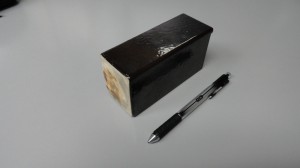
Transformer Blocking Shows Its Age
MIDWEST’s Engineering Department has a shelf with miscellaneous parts that we use for training. One of the items is a very simple 2” X 2” X 5” porcelain block. This is from a 1000 kva, 13,200 volt primary to 480/277 volt secondary, dry type power transformer. The transformer was one of seven new transformers installed in the 1960s at a customer’s commercial facility. MIDWEST’s service included cleaning and inspecting the transformers. They ranged in size from 500 kva 120/208 to 2000 kva 480/277 volts. The transformers were very clean from service by many companies over the years. All the test results were good. Previous maintenance notes classified all the transformers as “Excellent condition for continued service.” This facility handled critical data processing and the “results of failure” would include lose of power to data processing equipment. MIDWEST’s physical inspection revealed the winding blocking for one of the transformers was loose. Much of the upper blocking was so loose it could be removed. The porcelain block in our training room was taken from one of the 1000 kva dry transformers after it was replaced two years later. But based solely on the test results and a cursory visual inspection, the transformers looked great. The only problems were defective fans. But a focused inspection, TBLR in our jargon, a “top to bottom, left to right” hard focused inspection revealed very brittle insulation and loose blocking that could not be secured. The transformers ‘might’ have lasted another 20 years, but not reliably and this owner wanted reliability. So based on the physical condition, not the test results, the customer initiated a 5 year plan to replace the transformers and some of the associated secondary switchgear. This is another example of the value of experience when servicing power transformers, old, used, new, GE General Electric, Siemens, or Cutler Hammer, it doesn’t make a difference.
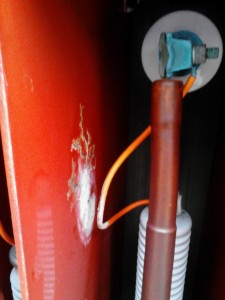
High Voltage Switch Interphase Barrier being destroyed by high voltage corona and tracking
If you’re a manufacturing plant and your main electrical power transformer is a 10 MVA, 10,000 kva, oil filled station type transformer, you’re probably not interested in failure modes and probability analysis from your service company. You just want to know everything is being done to make sure it doesn’t failure. In the world of sophisticated test procedures and test equipment and lengthy specifications for the application of the procedures to your 5 MVA, 10 MVA, or even 50 MVA high voltage power transformer, there is still need for old fashion maintenance and inspection services. Too often the main high voltage power transformer for a facility can never be turned off because of the interruption of production or data processing. We know that is the real world today and we have to deal with it in the best way possible to maintain reliability. Periodic combustible gas analyses and routine oil analysis are extremely useful. But there is still room for some old fashion basic maintenance services. MIDWEST likes “Ultrasonic Scanning” of medium voltage and high voltage equipment for indications of destructive corona or tracking. We recommend this on high voltage equipment, especially metal enclosed. And if you have a 20 MVA oil filled power transformer, you have something in front of it to protect it. If that protection fails, your transformer becomes very unhappy. For example, it is not unusual for us to find destructive corona or tracking damage to the inter-phase barriers in the high voltage switch protecting a power transformer. A good example is a lightning arrester lead that rests against the inter-phase barrier and is slowing destroying the barrier. Eventually one of the barriers will fail, usually a phase to phase fault and frequently during a lightning storm when a voltage surge screams down the line into the high voltage switch. Ultrasonic Scanning of the high voltage transformer main switch would catch this before it fails. Not real sophisticated, but an extremely effective preventive procedure. Find it, Fix it before it fails.
Categories: Uncategorized Tags: Combustible Gas Analyses, Destructive Corona, Destructive Tracking, electrical power transformer, High Voltage Equipment, High Voltage Switch, inter-phase barriers, Lightning Arrester, MVA, oil filled transformer, power transformer, Routine Oil Analysis, Ultrasonic Scanning
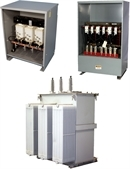 MIDWESTwas recently asked again why we don’t sell some of our rental transformers. This is a question often asked after power has been restored as fast as possible using temporary equipment instead of permanent repair involving a long time delay. There are many reasons we try not to sell some of our rental power transformers. The transformer may have an attached high voltage fused switch with lightning arrestors and cabling from the switch to the transformer already installed. A rental pad mount power transformer may be mounted on a skid and already have openings for conduit for the high voltage cables and for the temporary low voltage cables. There may be a main breaker already mounted on the secondary. Some rentals have unusual voltages or many voltage taps not found on typical power transformers, making them much more valuable as a rental than for permanent installation. Some transformers are too old to justify the cost of permanent installation. Some may have unusual primary or secondary physical configurations that are okay for a temporary transformer installation, but too difficult or expensive for permanent installation. Older transformers are physically much larger than same kva and voltage new power transformers, which may make the installation of the older rental power transformer not practical or too expensive. Most of all, many requests to rent a transformer, are an urgent need to get power back up as fast as possible, which frequently means temporarily. Then the owner can more calmly figure out what they want for permanent repair, considering cost and future needs.
MIDWESTwas recently asked again why we don’t sell some of our rental transformers. This is a question often asked after power has been restored as fast as possible using temporary equipment instead of permanent repair involving a long time delay. There are many reasons we try not to sell some of our rental power transformers. The transformer may have an attached high voltage fused switch with lightning arrestors and cabling from the switch to the transformer already installed. A rental pad mount power transformer may be mounted on a skid and already have openings for conduit for the high voltage cables and for the temporary low voltage cables. There may be a main breaker already mounted on the secondary. Some rentals have unusual voltages or many voltage taps not found on typical power transformers, making them much more valuable as a rental than for permanent installation. Some transformers are too old to justify the cost of permanent installation. Some may have unusual primary or secondary physical configurations that are okay for a temporary transformer installation, but too difficult or expensive for permanent installation. Older transformers are physically much larger than same kva and voltage new power transformers, which may make the installation of the older rental power transformer not practical or too expensive. Most of all, many requests to rent a transformer, are an urgent need to get power back up as fast as possible, which frequently means temporarily. Then the owner can more calmly figure out what they want for permanent repair, considering cost and future needs.
There are many technical reasons for using an oil filled power transformer or for using a dry type power transformer. But sometimes the reasons might be a bit of self interest. One example that MIDWEST runs into deals with customers that have a great need to monitor the condition of their power distribution equipment. There may be many reasons for this. Some, certainly justified, say for a mission critical facility, and some less important. But for a MIDWEST field service engineering technician, they would much rather test the dielectric fluid, oil, of a transformer than go through the work of testing an equal Kva dry type transformer. Dry type transformers have to be taken out of service and that usually means weekend or holiday work. Weekend or holiday work is not family friendly. It would take a technician maybe 10 minutes to sample the fluid in a 2000 kva oil filled substation power transformer, including a thorough technical and safety inspection of the transformer. The sample is turned over to the lab for a complete battery of tests. The results of these tests are very informative, especially when there is a history of test results. Lots of data and Electrical Power Engineers love lots of data. The tests may include a group of standard dielectric fluid tests, plus combustible gas-in-oil tests, furan tests, and power factor tests. And, of course, the ever important and super sophisticated smell and visual test performed by the experienced service technician on site. A nice technical package. The site inspection of the transformer by an experienced technician is extremely important. Whereas the visual inspection and dielectric tests performed on a 2000 kva dry transformer have very limited value in real time or for historical data tracking. So, if the choice is 4 hours during a weekend or over a holiday versus 15 minutes during normal work hours and with much better information, the choice would be 15 minutes and the oil filled transformer.
Categories: Uncategorized Tags: 2000 Kva Dry Transformer, 2000 KVA Oil Filled Substation Power Transformer, Combustible Gas-in-Oil Tests, dielectric fluid, Dielectric Fluid Tests, dry type transformers, Electrical Power Engineers, Engineering Technician, Field Service, Furan Tests, Kva Dry Type Transformer, Oil Filled Power Transformer, Oil Transformer, Power Distribution Equipment, Power Factor Tests






 MIDWEST
MIDWEST